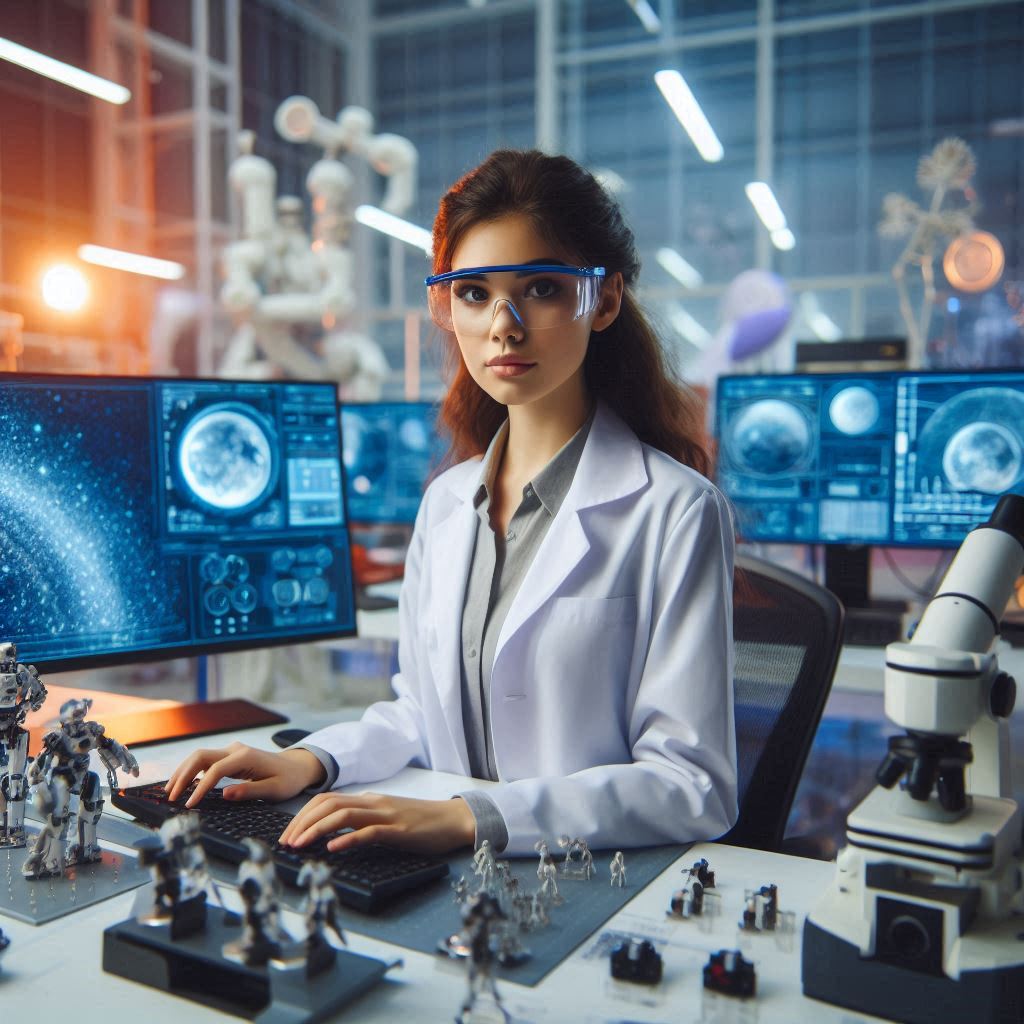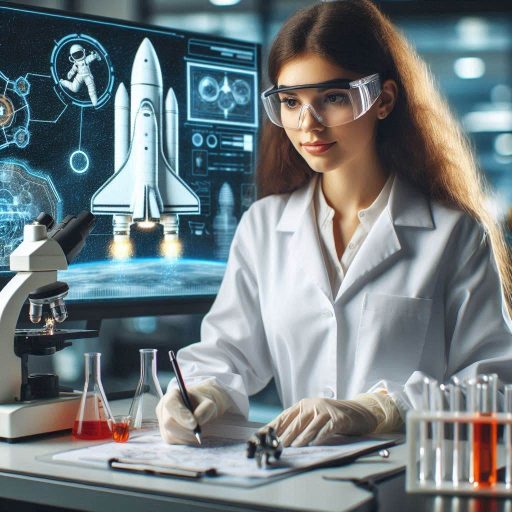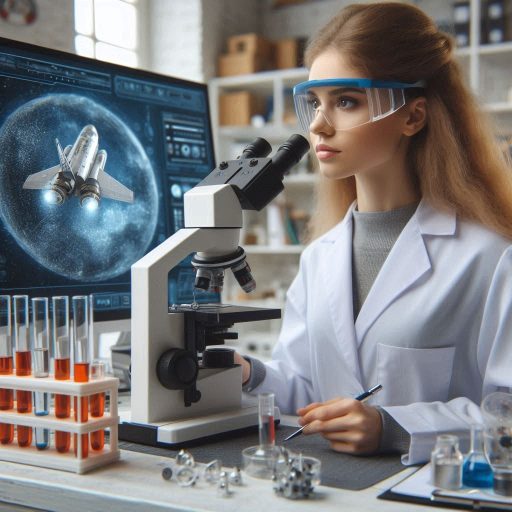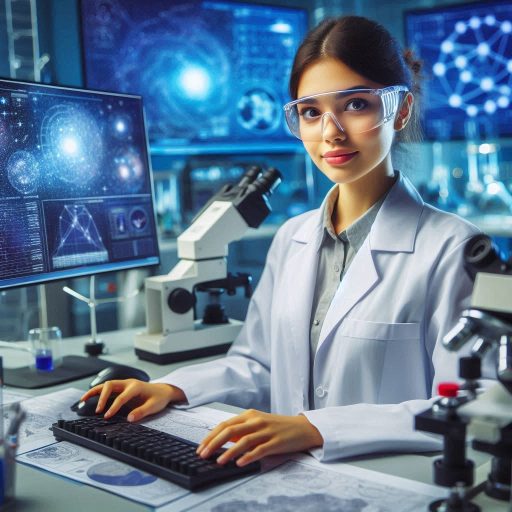Introduction
Space science conferences and events play a vital role in advancing our understanding of the universe and our place within it.
These gatherings provide opportunities for professionals to share research, findings, and innovations in the ever-evolving field of space science.
Attendees gain valuable insights into current trends, technological advancements, and breakthroughs that shape space exploration and technology.
By discussing their work, scientists and researchers contribute to a collective pool of knowledge that drives the field forward.
The importance of these events cannot be overstated.
They facilitate collaboration among scientists, engineers, and policymakers, fostering interdisciplinary approaches to complex challenges.
By encouraging dialogue among experts from diverse backgrounds, these conferences help generate innovative solutions to pressing issues in space exploration.
Networking opportunities enable participants to form valuable connections, leading to potential partnerships and collaborative projects that enhance scientific research.
Conferences also play a crucial role in inspiring the next generation of space scientists.
They attract students and enthusiasts eager to learn more about the field and engage with leading professionals.
By providing a platform for showcasing new ideas, technologies, and research, these events help ignite passion and curiosity among younger audiences.
Overview of Space Science Conferences
Space science conferences and events play a crucial role in advancing our understanding of the universe and promoting collaboration among experts in the field.
These conferences come in various forms, each serving a specific purpose in furthering space exploration and research.
Types of Space Science Conferences
- International Conferences: These events bring together scientists, researchers, and policymakers from around the world to discuss the latest discoveries and trends in space science.
- Regional Conferences: Regional conferences focus on specific areas or countries, allowing for more localized discussions and collaborations within the space science community.
- Industry Conferences: These events cater to professionals working in the space industry, providing a platform for networking, showcasing new technologies, and discussing business opportunities.
- Academic Conferences: Academic conferences are geared towards scholars and students, offering a space for presenting research findings, exchanging ideas, and fostering academic growth in the field of space science.
Purpose and Goals of Space Science Conferences
The primary purpose of space science conferences is to facilitate the exchange of knowledge, ideas, and advancements in the field.
These events serve as platforms for networking, collaboration, and inspiration for all attendees, from seasoned experts to young researchers.
Additionally, space science conferences aim to promote interdisciplinary discussions, pushing the boundaries of traditional silos and fostering cross-disciplinary research collaborations.
By bringing together experts from various backgrounds, these conferences create a fertile ground for innovation and breakthroughs in space science.
Key Topics and Themes Discussed
Space science conferences cover a wide range of topics and themes that are crucial for advancing our understanding of the cosmos.
Some of the key areas often discussed include
- Planetary Exploration: Exploration missions to Mars, Venus, and other celestial bodies.
- Astrophysics: The study of celestial objects, such as stars, galaxies, and black holes.
- Space Technology: Advancements in spacecraft design, propulsion systems, and communication technologies.
- Space Policy and Governance: Discussions on regulations, international cooperation, and legal frameworks for space activities.
- Exoplanets and Astrobiology: The search for habitable exoplanets and potential extraterrestrial life.
These topics form the core of discussions at space science conferences, shaping the direction of future research and exploration efforts in the field.
By delving into these themes, experts aim to push the boundaries of human knowledge and expand our understanding of the universe.
Basically, space science conferences are essential gatherings that drive innovation, collaboration, and progress in the field of space exploration.
These events bring together the brightest minds in the industry, fostering discussions on cutting-edge research and breakthrough technologies that will shape the future of space science for years to come.
Read: Educational Path: Becoming a Geologist in the USA
International Astronautical Congress (IAC)
Significance of the IAC as One of the Largest and Most Prestigious Space Science Conferences
The IAC is significant for several reasons.
First, it attracts thousands of participants, including leading scientists, researchers, and industry representatives.
This diverse attendance creates a dynamic environment for networking and collaboration.
Participants share their expertise, fostering innovation and inspiring new ideas.
The conference typically includes a wide range of sessions, workshops, and panel discussions.
These cover various topics, from satellite technology to planetary exploration.
This breadth of subjects allows attendees to gain insights into different areas of space science.
Moreover, the IAC provides a platform for emerging researchers to present their work.
Early-career scientists can showcase their findings alongside established experts.
This exposure can lead to valuable connections and opportunities for collaboration.
Some Notable Past Editions and Highlights of the Event
The IAC has a rich history, with notable past editions highlighting its significance.
For instance, the 70th IAC in 2019, held in Washington, D.C., featured keynote speeches from influential leaders in space exploration.
NASA Administrator Jim Bridenstine emphasized the importance of international collaboration in space missions.
In 2021, the IAC took place in Dubai, where it focused on the theme “Inspire, Innovate & Discover for the Benefit of Humanity.
” This edition included a diverse lineup of speakers and sessions exploring future trends in space science.
Another memorable highlight was the 2018 IAC in Bremen, Germany, which showcased advancements in reusable launch systems.
Attendees participated in workshops that focused on sustainability in space activities.
These highlights reflect the conference’s commitment to addressing current challenges and future opportunities in space exploration.
Impact of the IAC on the Space Science Community
The impact of the IAC on the space science community is profound.
It fosters collaboration among international space agencies, private companies, and academic institutions.
This collaboration accelerates technological advancements and promotes shared goals in space exploration.
Furthermore, the IAC serves as a catalyst for new projects and initiatives.
Many partnerships formed during the conference lead to groundbreaking research and innovative technologies.
The IAC also influences policy discussions regarding space exploration.
Policymakers attend the conference to understand the latest developments and emerging trends.
This engagement helps shape future regulations and funding decisions in the space sector.
Basically, the International Astronautical Congress is a cornerstone event in the space science community.
Its significance lies in its ability to bring together diverse participants and foster collaboration.
Notable past editions showcase the conference’s dynamic nature and commitment to advancing space exploration.
The IAC’s impact on the community is substantial, influencing partnerships, innovations, and policies in the ever-evolving field of space science.
Read: Botany Career Fairs and Networking Events
American Astronomical Society (AAS) Annual Meeting
AAS Annual Meeting: A Prominent Conference
The AAS Annual Meeting occurs twice a year, usually in January and June.
It gathers thousands of professionals, including researchers, students, and educators.
The meeting features numerous sessions, workshops, and discussions.
Attendees present their latest findings and explore new ideas in astronomy and astrophysics.
This conference serves as a focal point for collaboration and innovation in the field.
Diverse Range of Topics Covered
The AAS Annual Meeting covers a diverse range of topics relevant to space science.
Participants can attend sessions on planetary science, cosmology, and stellar evolution.
Other sessions focus on observational techniques, data analysis, and theoretical models.
Researchers also present studies on exoplanets, dark matter, and gravitational waves.
This variety encourages interdisciplinary collaboration and fosters a broader understanding of astronomical phenomena.
In addition to formal presentations, the conference includes poster sessions.
These sessions allow researchers to showcase their work and engage in discussions.
Attendees can ask questions and provide feedback, facilitating knowledge exchange.
Networking opportunities abound, with many attendees forming connections that lead to future collaborations.
Recent Breakthroughs and Research Presented
At the recent AAS Annual Meeting, attendees showcased several exciting breakthroughs.
One significant presentation focused on the discovery of new exoplanets in habitable zones.
Researchers discussed the methods used to detect these planets and their potential for supporting life.
This finding generated enthusiasm and prompted discussions about future exploration missions.
Another noteworthy topic was the latest research on black holes.
Scientists shared new data from gravitational wave observatories, revealing insights into black hole mergers.
This research deepened our understanding of how these cosmic giants form and evolve.
Additionally, the conference highlighted advancements in observational technologies.
Researchers presented innovations in telescope designs and data collection methods.
These advancements improve our ability to explore distant galaxies and unravel cosmic mysteries.
Therefore, the AAS Annual Meeting is a prominent conference for astronomers and astrophysicists.
It covers a diverse range of topics, facilitating collaboration and knowledge sharing.
Recent breakthroughs presented at the meeting showcase the ongoing advancements in space science.
Attendees leave inspired and equipped with new ideas to explore the universe further.
Such conferences are crucial for the continued growth and innovation in the field of space science.
Read: Preparing for a Botany PhD: Tips and Advice
SpaceVision Conference
SpaceVision Conference: A Student-Run Conference
Firstly, SpaceVision is organized by students from the Students for the Exploration and Development of Space (SEDS).
This organization promotes student involvement in space-related initiatives.
The conference aims to inspire the next generation of space explorers and innovators.
It provides a platform for students to showcase their work and network with industry professionals.
Attendees come from diverse backgrounds, including engineering, science, and policy.
This diversity enriches discussions and fosters collaboration among participants.
SpaceVision highlights the importance of student contributions to the future of space exploration.
The event encourages creative thinking and problem-solving among its attendees.
Hands-On Workshops, Panels, and Networking Opportunities
SpaceVision features numerous hands-on workshops that allow participants to engage with space technology directly.
These workshops cover various topics, from rocket building to satellite design.
Participants gain practical experience and valuable skills during these sessions.
In addition to workshops, the conference hosts panels with industry experts.
These panels discuss current trends, challenges, and innovations in the space sector.
Attendees gain insights from professionals who share their experiences and knowledge.
This information helps students understand the evolving landscape of space exploration.
Networking opportunities abound at SpaceVision.
Participants connect with like-minded individuals, industry leaders, and potential collaborators.
These connections can lead to internships, job opportunities, and future partnerships.
The conference cultivates a supportive community that encourages sharing ideas and experiences.
Innovative Projects and Presentations at SpaceVision
SpaceVision showcases innovative projects and presentations that highlight cutting-edge research and technology.
Students present their work on topics such as space habitats, propulsion systems, and planetary exploration.
These presentations often feature groundbreaking concepts that push the boundaries of current technology.
For instance, past conferences have included projects on sustainable life support systems for long-duration missions.
Other presentations have focused on new materials for spacecraft design.
Such innovative ideas inspire attendees and spark discussions about future possibilities in space exploration.
Moreover, SpaceVision encourages collaboration on interdisciplinary projects.
Students from various fields work together to develop solutions to pressing challenges.
This approach fosters creativity and enhances the quality of presentations showcased at the conference.
Read: Interdisciplinary Research: Botany and Other Sciences
Transform Your Career Today
Unlock a personalized career strategy that drives real results. Get tailored advice and a roadmap designed just for you.
Start Now
Find Out More: How Archaeologists Contribute to Science and Research
European Space Conference
Overview of the European Space Conference as a Key Event for Industry Professionals and Policymakers
The European Space Conference stands out as a pivotal event for industry professionals and policymakers.
It brings together key stakeholders in the space sector.
Participants include representatives from government agencies, private companies, and research institutions.
The conference provides a platform for discussing pressing challenges and opportunities in space exploration.
Attendees engage in meaningful discussions about the future of space in Europe.
This event occurs annually, attracting a diverse audience dedicated to advancing space science and technology.
The European Space Conference features a variety of sessions focused on current topics in space.
These sessions cover areas such as satellite technology, space exploration, and environmental monitoring.
Workshops and panels facilitate knowledge sharing among participants.
This format encourages collaboration and the exchange of innovative ideas.
Attendees gain valuable insights into industry trends and technological advancements.
Impact of the Conference on Shaping European Space Policy and Collaborations
The conference plays a significant role in shaping European space policy.
Policymakers use this event to gather feedback from industry leaders and experts.
Their insights help inform policy decisions regarding funding, regulations, and strategic initiatives.
The discussions often focus on how to enhance Europe’s position in the global space market.
Moreover, the conference fosters collaborations among various stakeholders.
By connecting industry professionals with policymakers, the event encourages partnerships that drive innovation.
These collaborations can lead to joint projects and initiatives that benefit the entire European space ecosystem.
The conference also highlights successful case studies that inspire new approaches to space challenges.
The event’s outcomes often influence the European Space Agency’s (ESA) priorities and programs.
Policymakers use the information gathered during the conference to align funding with strategic goals.
This alignment helps ensure that resources are allocated effectively to address key challenges in space.
High-Profile Speakers and Discussions at the Event
The European Space Conference consistently features high-profile speakers from various sectors.
Renowned leaders in space exploration, technology, and research share their insights and experiences.
Their presentations offer valuable perspectives on the future of space in Europe and globally.
Attendees benefit from hearing about the latest developments and initiatives in the field.
Panel discussions often include representatives from leading space organizations.
Topics may range from the role of space in climate change to the commercialization of space.
These discussions provide a comprehensive view of the current landscape and future directions in space exploration.
Additionally, networking opportunities abound at the conference.
Participants can connect with potential collaborators, clients, and mentors.
This networking fosters relationships that can lead to future partnerships and projects.
In general, the European Space Conference serves as a vital gathering for industry professionals and policymakers.
It shapes European space policy and encourages collaborations across sectors.
With high-profile speakers and engaging discussions, the conference remains a cornerstone of the European space community.
Attending this event equips participants with knowledge and connections essential for advancing their work in space science and exploration.
Space Exploration Technology Conference (SET)
The SET Conference as a Forum for Showcasing Cutting-Edge Technologies in Space Exploration
The SET Conference focuses on various aspects of space exploration.
It brings together experts from academia, government, and the private sector.
Attendees participate in presentations, panel discussions, and workshops.
This format encourages dialogue and knowledge sharing among participants.
The conference covers topics such as satellite technology, propulsion systems, and robotic exploration.
Innovative technologies often debut at the SET Conference.
Companies and research institutions showcase their latest developments.
For example, new propulsion technologies might improve the efficiency of spacecraft.
Similarly, advancements in satellite design can enhance data collection and communication capabilities.
These innovations play a crucial role in expanding our reach into space.
New Developments or Advancements Presented at the Conference
At the most recent SET Conference, several groundbreaking advancements captured attendees’ attention.
One notable development was a new spacecraft design that incorporates sustainable materials.
This innovation aims to reduce the environmental impact of space missions.
Another highlight included advancements in artificial intelligence for autonomous spacecraft navigation.
These technologies promise to enhance mission success rates and reduce human oversight.
The conference also featured discussions on the latest research in planetary science.
Scientists presented findings from Mars missions, revealing new insights about the planet’s geology.
Additionally, experts shared data from lunar exploration efforts, highlighting potential future missions.
These presentations keep the community informed about the latest trends and discoveries.
Importance of Technology Conferences in Driving Progress in Space Science
Technology conferences like the SET Conference are essential for driving progress in space science.
They provide a platform for networking and collaboration among professionals.
Participants form connections that can lead to partnerships and joint projects.
This collaboration often results in innovative solutions to complex challenges.
Conferences also serve as an opportunity for education and professional development.
Attendees gain exposure to the latest research and methodologies.
This knowledge helps them stay current in a rapidly evolving field.
Furthermore, conferences stimulate discussions that can lead to new ideas and approaches.
Essentially, the SET Conference is a significant event in the space science community.
It showcases cutting-edge technologies and highlights new developments in the field.
The importance of technology conferences cannot be overstated.
They drive progress, foster collaboration, and educate professionals.
Ultimately, these gatherings play a critical role in expanding our knowledge of space and advancing exploration efforts.
Conclusion
Space science enthusiasts often gather at popular conferences and events dedicated to expanding knowledge and collaboration.
These gatherings provide a platform for experts and enthusiasts to share cutting-edge research and innovations.
Attendees have the opportunity to engage in discussions, workshops, and networking sessions with like-minded individuals.
One of the most famous space science conferences is the International Astronautical Congress, attracting professionals worldwide.
Another notable event is Space Symposium, where industry leaders gather to discuss the latest developments in space exploration.
These conferences play a vital role in fostering collaboration among scientists, engineers, and space enthusiasts.
By providing a space for sharing ideas and experiences, these events drive innovation in the field of space science.
Moreover, conferences and events serve as a platform for showcasing new technologies and breakthrough discoveries in the industry.
In summary, popular space science conferences and events are essential for advancing the field.
They promote collaboration, innovation, and knowledge sharing among experts and enthusiasts.
Consider staying updated on upcoming conferences and events to expand your network and stay informed.




